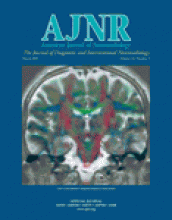Abstract
BACKGROUND AND PURPOSE: Reported CT angiographic (CTA) subtraction methods are not simple, robust, or real time. We investigated a novel technique for semiautomated digital subtraction CTA of the intracranial and extracranial arteries.
METHODS: Thirty patients underwent precontrast (low milliampere-seconds) and postcontrast (pitch, 1.5; collimation, 1–2.5 mm) helical imaging with a vacuum-type head holder to facilitate image registration and minimize movement. A reconstructed three-dimensional model of the precontrast bone dataset was subtracted from the postcontrast dataset to produce subtracted maximum-intensity-projection angiograms. Experienced (operator 1) and less-experienced (operator 2) staff performed the standard and subtraction reconstructions, and image generation time and quality (graded 1–5) were compared. A third operator blinded to the method assessed the hard-copy image quality.
RESULTS: Image quality with subtraction postprocessing was significantly better with both operators (operator 1, mean improvement of 0.87 grade, median improvement of 1 grade, P < .001; operator 2, mean improvement of 0.63 grade, median improvement of 1 grade, P < .001). Hard-copy image quality was better with the subtraction method (operator 1, P > .001; operator 2, P < .001). Blood vessels at the base of the brain were better demonstrated on subtraction images in 13 of 14 examinations. For the less experienced operator, the reconstruction time was significantly less with the subtraction method than with the conventional method (mean, 7.5 vs 10.1 minutes; P = .001).
CONCLUSION: When separation of the vasculature from bone is important and technically difficult, digital subtraction CTA offers a potential advantage. This semiautomated technique is fast and easy to learn, and variably experienced staff can use it.
- Copyright © American Society of Neuroradiology












